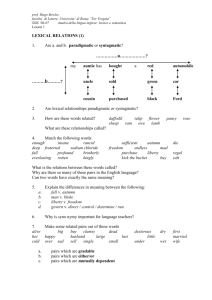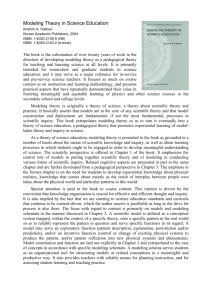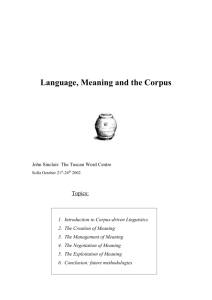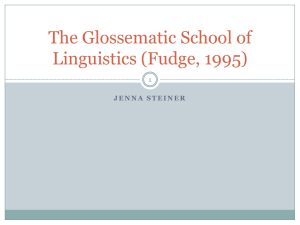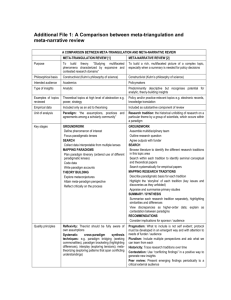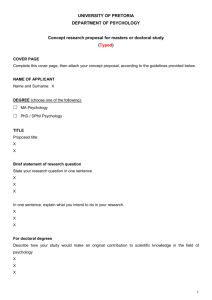CLUSTERING SYMBOLIC MUSIC USING PARADIGMATIC AND SURFACE LEVEL ANALYSES University of Helsinki
advertisement
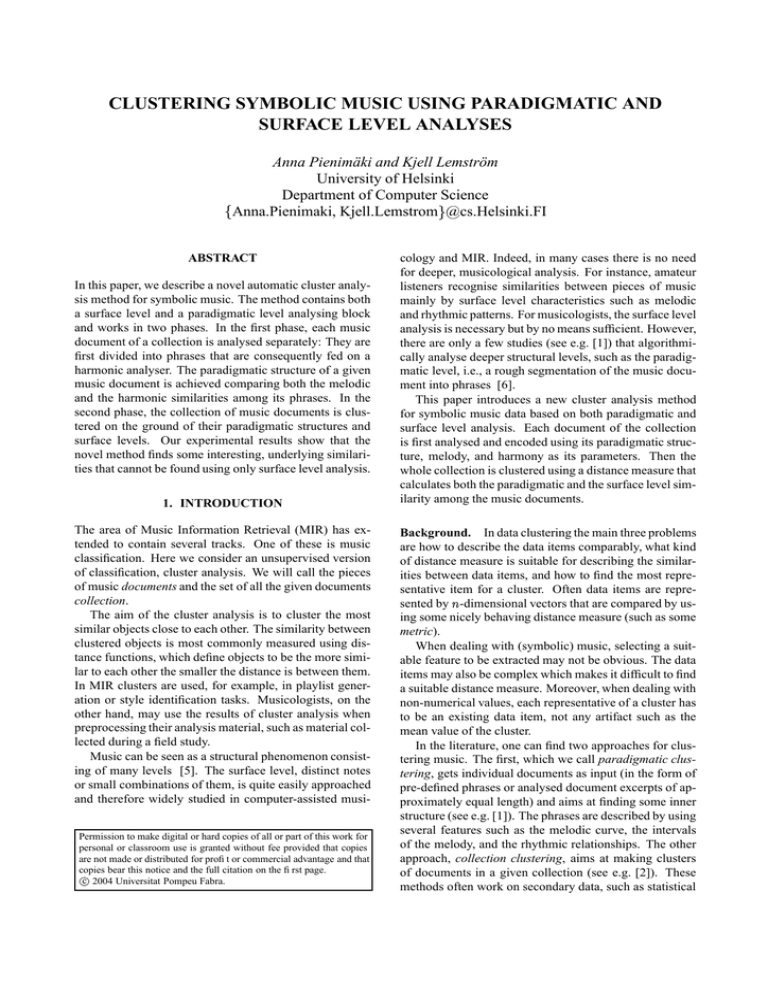
CLUSTERING SYMBOLIC MUSIC USING PARADIGMATIC AND
SURFACE LEVEL ANALYSES
Anna Pienimäki and Kjell Lemström
University of Helsinki
Department of Computer Science
Anna.Pienimaki, Kjell.Lemstrom @cs.Helsinki.FI
ABSTRACT
In this paper, we describe a novel automatic cluster analysis method for symbolic music. The method contains both
a surface level and a paradigmatic level analysing block
and works in two phases. In the first phase, each music
document of a collection is analysed separately: They are
first divided into phrases that are consequently fed on a
harmonic analyser. The paradigmatic structure of a given
music document is achieved comparing both the melodic
and the harmonic similarities among its phrases. In the
second phase, the collection of music documents is clustered on the ground of their paradigmatic structures and
surface levels. Our experimental results show that the
novel method finds some interesting, underlying similarities that cannot be found using only surface level analysis.
1. INTRODUCTION
The area of Music Information Retrieval (MIR) has extended to contain several tracks. One of these is music
classification. Here we consider an unsupervised version
of classification, cluster analysis. We will call the pieces
of music documents and the set of all the given documents
collection.
The aim of the cluster analysis is to cluster the most
similar objects close to each other. The similarity between
clustered objects is most commonly measured using distance functions, which define objects to be the more similar to each other the smaller the distance is between them.
In MIR clusters are used, for example, in playlist generation or style identification tasks. Musicologists, on the
other hand, may use the results of cluster analysis when
preprocessing their analysis material, such as material collected during a field study.
Music can be seen as a structural phenomenon consisting of many levels [5]. The surface level, distinct notes
or small combinations of them, is quite easily approached
and therefore widely studied in computer-assisted musiPermission to make digital or hard copies of all or part of this work for
personal or classroom use is granted without fee provided that copies
are not made or distributed for profit or commercial advantage and that
copies bear this notice and the full citation on the first page.
c 2004 Universitat Pompeu Fabra.
cology and MIR. Indeed, in many cases there is no need
for deeper, musicological analysis. For instance, amateur
listeners recognise similarities between pieces of music
mainly by surface level characteristics such as melodic
and rhythmic patterns. For musicologists, the surface level
analysis is necessary but by no means sufficient. However,
there are only a few studies (see e.g. [1]) that algorithmically analyse deeper structural levels, such as the paradigmatic level, i.e., a rough segmentation of the music document into phrases [6].
This paper introduces a new cluster analysis method
for symbolic music data based on both paradigmatic and
surface level analysis. Each document of the collection
is first analysed and encoded using its paradigmatic structure, melody, and harmony as its parameters. Then the
whole collection is clustered using a distance measure that
calculates both the paradigmatic and the surface level similarity among the music documents.
Background. In data clustering the main three problems
are how to describe the data items comparably, what kind
of distance measure is suitable for describing the similarities between data items, and how to find the most representative item for a cluster. Often data items are represented by -dimensional vectors that are compared by using some nicely behaving distance measure (such as some
metric).
When dealing with (symbolic) music, selecting a suitable feature to be extracted may not be obvious. The data
items may also be complex which makes it difficult to find
a suitable distance measure. Moreover, when dealing with
non-numerical values, each representative of a cluster has
to be an existing data item, not any artifact such as the
mean value of the cluster.
In the literature, one can find two approaches for clustering music. The first, which we call paradigmatic clustering, gets individual documents as input (in the form of
pre-defined phrases or analysed document excerpts of approximately equal length) and aims at finding some inner
structure (see e.g. [1]). The phrases are described by using
several features such as the melodic curve, the intervals
of the melody, and the rhythmic relationships. The other
approach, collection clustering, aims at making clusters
of documents in a given collection (see e.g. [2]). These
methods often work on secondary data, such as statistical
ing recurrence resembling the conventional edit distance:
characteristics of the melody.
Our novel method, to be described in the following sections, combines ideas of both of these approaches. It first
segments each document of the collection into phrases;
the phrase similarity is based both on the melodic line
and on the harmonic analysis of the excerpt containing
the phrase at hand. The paradigmatic structure of the documents is obtained by cluster analysis using information
collected during the former phase. To describe the documents we use adjacency lists; each such list is associated with a document and stores results of paradigmatic
and surface level analyses of the corresponding document.
The whole collection can then be clustered by using the
adjacency lists.
2. CLUSTERING PARADIGMATIC LEVEL
USING SURFACE LEVEL INFORMATION
Let us now describe how we analyse individual documents. This includes describing the surface level and then
forming paradigmatic clusters based on the surface level
descriptions. The adjacency list storing these results is described in Section 3.
Temperley has introduced heuristics for segmenting
monophonic music into phrases [7]. In order to apply
them here, we need a melody extraction method because
our collection contains mainly polyphonic documents.
For the moment, we use a simplistic approach that considers notes with the highest pitch values as melody.
Having applied Temperley’s phrase segmentation, we
have the melodic phrases. For each melodic phrase, we
also need the associated polyphonic context, the harmonic
phrase. Having extracted these out of the original document, we analyse them using Temperley’s harmonic analysis heuristics [7]. Because the length of the harmonic
phrases may vary, we compress them by replacing runs of
any symbol with a single symbol. For instance, string
is replaced by .
Let be a string of length on an
alphabet . We use such strings to represent extracted
phrases: Let be such an extracted phrase. Then !"#$ and &%'(&%)*+% represent
its melodic and harmonic parts, respectively. If there are
,
extracted phrases for some document - , we form a sim,21",
ilarity matrix
, such that the cell .346/ 5 7 , for
, .0/ of size
8:9+<;=8 , is given by the formula:
A TV% U
I
\]]
(2)
AHaT % `!b 5 U D d c
^ AHT % 5 U`!b D d c
WYX[Z ]_]
AHTa% `!b 5 U`!b D (if O e#&f+M# gd then I
else h B eig C ) The distance between strings and M can then be found
reading the value of the entry A2jl% k . The additional part,
h B eig C , takes into account musicological findings. It is
defined as follows. h B eQg C \]]
]] 9 b if O e## M gl are inversions of same chord
]]
9ml if O
e##&Ma gl are different chords of same
^
function
WYX[Z ]]]
9
l
n
if
O e##&Ma gl are major and minor forms of
]]]_
same chord
d otherwise The coefficients 9 b , 9 m , and 9n (9 b 8o9 m 8p9n ) enable
weighting between functional differences of chords. The
functions of the chords are defined traditionally: the tonic
function includes chords and , the subdominant and q , the dominant and q . The chord q belongs
in class others.
The melodic edit distance, A2 , in Equation 1 is calculated by using the straightforward transposition invariant
edit distance, AYr , as defined in [4].
Paradigmatic Level Clustering. In paradigmatic level,
we cluster together phrases that can be seen as variants
of one common phrase. The result is often represented
as a string of paradigm symbols, such as ABCCA. Thus,
paradigmatic level suggests also a rough segmentation for
the document.
To find the cluster, we iterate the similarity matrix .s4>/ 5 7
(Equation 1). Between each iteration, the similarity matrix is updated using the complete link approach (see e.g.
[3]) that tends to build spherical clusters. The iteration is
halted when the values in the similarity matrix exceed a
predefined threshold value t . The paradigms are labeled
in the alphabetic order starting with A.
3. CLUSTERING MUSIC COLLECTION
C (1)
. 4>/ 5 7 (?3@A %B 4% %7=CD B FEG? C @A "B 4 72
where A2 and AH% are melodic and harmonic edit distances, respectively, as defined below. Factor ? (IJ8K?L8
) adjusts the weights of the components.
The harmonic distance, A2% , on two strings and M of
lengths N ONP
and N &MQNPR is calculated by the follow
A S % S
The results of the analyses described above are stored into
an adjacency list (Fig. 1). The main body of this structure, which is merely an array of header cells, is conceptually divided into two parts: paradigmatic and surface
level parts. The header cell of the paradigmatic part contains a link to the formed paradigm string. The surface
level part contains varying amounts of header cells, one
for each paradigm. For each such header cell, there is a
link to a list containing two strings that represent the associated harmonic and melodic phrases. When a paradigm
has several variations, the phrase with the lowest distance
to all the other variations is opted for the representative
phrase of the paradigm.
1
size
, such that the cell .T 5 U Y8KeQg$8
by the formula:
. T 5 U ?m@A B T U C D B EG?m C @sWYX Z
^
, is given
\
b
A B
_ A m B
A n B
T #
T #
T #
U C
U C
U C
(3)
where ? m ( I$8? m 8 ) is a parameter used to adjust the
relative weight between paradigmatic and surface level
structures. Let N N be the number of paradigms in document , and Ro W B N N 6N >MQN C . Now, A B d
M C gives the
surface level similarity and is defined by the formula:
Figure 1. Adjacency list corresponding to document.
Recall that when we measure the similarity of two music documents, we want to combine the similarity of their
paradigmatic structures with the similarities of the corresponding surface levels. Once we are able to do that,
we can construct a similarity matrix (analogous to that of
Equation 1) for all the documents in a given collection.
Then we can cluster the whole collection using the constructive hierarchical algorithm that was already used for
paradigmatic clustering. The resulting dendrogram will
give us the hierarchical structure of the collection.
analysed documents
To that end,
let ,- +and
-
M be two
and let , and d
>M denote the asM&
sociated paradigm and surface strings, respectively. The
straightforward way to couple - and -M together would be
to align paradigms sharing the same label and calculate
the corresponding surface level (phrase) similarities. Naturally, this may not be the optimal choice because the labeling process is consistent only over a single document.
When having a closer look at the paradigm strings of and + M above, one can hypothesise that coupling
where
and in the first string are aligned with and in the
second, respectively, may result in a more appropriate interpretation. Obviously the optimal coupling depends on
the corresponding surface level structures and 6M , not on
the paradigm labels.
Since the optimal coupling is computationally very expensive, we have implemented a greedy version that results in nearly optimal coupling in most of the cases. For
assessing the similarity of two paradigm strings, we have
implemented three distance measures based onb the edit
distance framework. The first, denoted by A , is very
straightforward, yet in many cases effective. It applies
conventional edit distance (with deletion, insertion, and
substitution operations) to the paradigm strings without
m
any relabeling. The second, A , is based on Hamming
distance (the only allowed editing operation is substitution) and behaves more nicely in the cases where the two
strings clearly share a similar structure, but one string is
m
much longer than the other. The third, A n , works as A
but also relabels the paradigm string M accordingly with
by using the alignment given by the greedy coupling.
Let and denote the paradigm and surface level
strings of some document
- , and the number of docu
ments in collection . We form a similarity matrix . of
A B d M C k
T
b
B . / 5 C m (4)
where .3/ is the surface distance defined in Equation 1.
The paradigms compared, T and MT , are selected using the
N >MQN the paradigms without pairs
greedy coupling. If N N '
are compared to null strings.
The minimum operation in Equation 3 opts for one
of the possibilities for paradigmatic
structure similarities.
b
While the intuition of A
should be obvious (see e.g. [4]),
m (and A n ) requires further explaining.
the idea behind A
This is done in the following paragraph.
Ignoring Repetitions. Let us have two strings and M
of
and N &MQN R , such that fE R N N !#" lengths
.
When
applying
the! conventional edit distance,
I
b
b
although the structure of A , to them, A B #+M C%$
may
just
be
a
prolonged
version
& and +M& & .of M , like in case: Now, if we consider the shorter string as a search pattern to be searched for in the longer string, we can easily
see that M occurs exactly in at positions 1, 4, and 7. This
suggestsb that &M and are paradigmatically much closer
than A B &M C (' would hint. It is well-known that the
edit distance framework can be straightforwardly adapted
to the pattern matching case. Now, instead of finding the
minimum value at the bottom row of the dynamic programming table computing the matching process, we collect ) N N * N &MN + minimum values. The mean value of this
set is given as the distance between the two strings.
In order to obtain meaningful results in doing so, we
need to apply the Hamming distance. This is due to the
well-known fact that the adjacent values in the dynamic
programming table vary at most by one when allowing insertions, deletions and substitutions. If done so, in the
resulting difference one perfect occurrence may be accounted several times, giving a small score although the
structures would have been rather dissimilar.
m
As for an example of our measure A , let us consider
and &M as given above. The bottom row of the dynamic
programming table would be 3, 3, 0, 3, 3, 0, 3, 3, 0 and
)-,./ , +$10 . Because there are three zeros in the bottom
,. ,
m
row (three exact occurrences of the pattern), A B # M C intuitively better the
I . In this case, the result describes
b
similarity of and &M than A B #+M C 2' . At this point,
n
the functioning of A , as explained above, should have
become obvious, as well.
4. EXPERIMENTAL RESULTS
Let us now describe briefly our implementation, the influence of coefficients used, the test sets, and the main
results obtained. As mentioned in Section 2, we used segmentation and harmonic analysis modules based on Temperley’s heuristics [7]. Implementations of them can be
found freely available for non-commercial use 1 . We implemented the melody extraction, clustering, and distance
calculation algorithms as Perl scripts. The data flow between various scripts was managed by a shell script.
We studied the behaviour of the method using two test
sets containing documents in MIDI format. The first set
contained 48 short fragments of classical pieces. This set
was used mainly for evaluating the functionality of the
method. For more thorough analysis of the method we
built the second test set by choosing 145 classical pieces
randomly from the Mutopia 2 database. The size of the
second set was intentionally kept as small as possible,
because of the huge amount of handiwork needed when
analysing the results of the clustering.
First we studied the paradigmatic clustering phase. We
experimented on various threshold values t . At each considered value, we generated a list of adjacency lists and
analysed the quality of paradigmatic clustering. We found
that the threshold value 20 gave the best paradigmatic
clustering result in this data set.
We experimented also on the coefficient ? of Equation 1. In the first experiment the value of ? in paradigm
matic phase was set in n . We found that the harmonic
analysis had difficulties with surface level chromaticism
and the results skewed the paradigmatic clustering, as
well.
In the second experiment we set the value of ? in
b
. In this case, the problems of the chromaticism did not
dominate the paradigmatic clustering as strongly as in the
first experiment.
The coefficients 9 b , 9 m , and 9n were set in 0.25, 0.5
and 0.75, respectively. In future, we will evaluate a wider
range of values for them.
In the collection clustering phase we experimented on
coefficient value ? m . We used ? m in testing the importance
of paradigmatic structure setting ? m to be 1 and thus eliminating its influence. We found that when setting the value
of ? m very high, the resulting hierarchical structure was
constructed mostly on the basis of occasional similarities
on the surface level. These similarities are of course interesting in such research problems that aim at finding,
for instance, similar melodic patterns from music documents. In our case, however, these similarities, especially
when occurring without wider musicological context, are
not very interesting.
When the value of ?m was set low thus stressing the influence of the paradigmatic level similarities the resulting
1
2
http://www.link.cs.cmu.edu/music-analysis/
http://www.mutopiaproject.org/
structure was altered. We found that certain documents
that were located near to each other when the surface level
similarity was stressed, were in the same subcluster also
when stressing the paradigmatic level similarity. In this
case we found both paradigmatic and surface level similarities between the documents when examining the adjacency lists of the documents. In many cases, however,
the similarity between certain documents was noticeable
in the hierarchical clustering structure only when stressing the paradigmatic level similarity. This behaviour was
characteristic of documents containing especially Bach’s
compositions. This kind of similarity could not be found
by examining only the surface level of the documents.
5. CONCLUSION
We described a novel automatic analysis method based on
paradigmatic and surface level similarity of music represented in symbolic form. Our experimental results on the
method were encouraging, given the simplicity of it. Because of the modular structure, our method is easily customised: other surface level descriptions, such as statistical parameters, can be accommodated by adding a term
into Equation 1.
6. REFERENCES
[1] Cambouropoulos E. and Widmer, G., “Automatic motivic analysis via melodic clustering”, Journal of New Music Research 29(4),
pp. 303–317, 2000.
[2] Eerola, T., Järvinen, T., Louhivuori, J., and
Toiviainen, P. “Statistical features and perceived similarity of folk melodies”, Music Perception 18, pp. 275–296, 2001.
[3] Hand, D., Mannila, H., and Smyth, P., Principles of Data Mining. MIT Press, Cambridge,
Mass., 2001.
[4] Lemström, K. and Ukkonen, E., “Including interval encoding into edit distance based music
comparison and retrieval”, Proc. AISB Symposium on Creative & Cultural Aspects and Applications of AI & Cognitive Science, Birmingham, UK, pp. 53–60, 2000.
[5] Lerdahl, F. and Jackendoff, R., A Generative Theory of Tonal Music. MIT Press, Cambridge, Mass., 1983.
[6] Nattiez, J.-J., Music and Discourse – Toward
a Semiology of Music. Princeton University
Press, 1990.
[7] Temperley, D., The Cognition of Basic Musical Structures. MIT Press, Cambridge, Mass.
2001.
